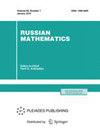两个独立变量情况下半线性双曲方程考希问题的经典解法
IF 0.5
Q3 MATHEMATICS
引用次数: 0
摘要
摘要 在上半平面内,我们考虑一个高于二阶的半线性双曲偏微分方程。方程中的算子是一阶微分算子的组成。该方程附带有 Cauchy 条件。解以隐式解析形式构造为某个积分方程的解。该方程的局部可解性由巴纳赫定点定理和/或肖德定点定理证明。该方程的全局可解性由勒雷-肖德定点定理证明。对于有关问题,证明了解的唯一性,并确定了其经典解存在的条件。本文章由计算机程序翻译,如有差异,请以英文原文为准。
Classical Solution to the Cauchy Problem for a Semilinear Hyperbolic Equation in the Case of Two Independent Variables
Abstract
In the upper half-plane, we consider a semilinear hyperbolic partial differential equation of order higher than two. The operator in the equation is a composition of first-order differential operators. The equation is accompanied with Cauchy conditions. The solution is constructed in an implicit analytical form as a solution to some integral equation. The local solvability of this euqation is proved by the Banach fixed point theorem and/or the Schauder fixed point theorem. The global solvability of this equation is proved by the Leray–Schauder fixed point theorem. For the problem in question, the uniqueness of the solution is proved and the conditions under which its classical solution exists are established.
求助全文
通过发布文献求助,成功后即可免费获取论文全文。
去求助
来源期刊

Russian Mathematics
MATHEMATICS-
CiteScore
0.90
自引率
25.00%
发文量
0
期刊介绍:
Russian Mathematics is a peer reviewed periodical that encompasses the most significant research in both pure and applied mathematics.
 求助内容:
求助内容: 应助结果提醒方式:
应助结果提醒方式:


